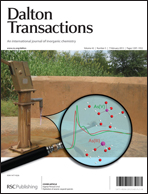Tetranuclear homo- (ZnII4 and CdII4) and hetero-metal (ZnII2TbIII2 and CdII2TbIII2) complexes with a pair of carboxylate ligands in a rare η2:η2:μ4-bridging mode: syntheses, structures and emission properties†
Abstract
Four tetranuclear complexes involving both homo- and hetero-metal combinations, viz. [ZnII2L2(μ4-PhCOO)2ZnII2(hfac)2] (1), [CdII2L2(μ4-PhCOO)2CdII2(hfac)2] (2), [ZnII2L2(μ4-PhCOO)2TbIII2(hfac)4] (3), and [CdII2L2(μ4-PhCOO)2TbIII2(hfac)4] (4) have been prepared following a single-pot synthesis protocol using N,N′-dimethyl-N,N′-bis(2-hydroxy-3,5-dimethylbenzyl)ethylenediamine (H2L) as a primary ligand. Both benzoate and hexafluoroacetylacetonate (hfac−), used here as ancillary ligands, play crucial roles in generating a tetranuclear core with high thermodynamic stability. Oxygen atoms of each carboxylate moiety bind all the four metal centers together in a rare η2:η2:μ4-bridging mode as confirmed by X-ray crystallography. In the homo-metallic complexes (1 and 2), the metal centers are all lying in a square plane, each occupying a corner, and remain connected together by oxygen bridges forming octagonal metallacrowns. These structures remain intact in solution as confirmed by 1H NMR spectroscopy and photoluminescent studies. In the hetero-metal complexes (3 and 4), the metal centers are arrayed in alternate positions of the tetranuclear core. The TbIII centers have eight coordinate bi-capped trigonal prismatic coordination environments with different degrees of distortions. The all oxygen O8 core surrounding each TbIII center is devoid of solvent molecules that make fluorescent emission from these molecules (3 and 4) quite interesting. The hfac−-based 1(π–π*) emissions observed in 1 and 2 are quenched in 3 and 4. These sensitized TbIII emissions [5D4 → 7Fj; j = 6, 5, 4, and 3] are influenced by the local environments surrounding the 4f-metal center. The lifetime for the luminescence decay of 3 (5D4 → 7F5 transition) is about 1.5 times longer than that of 4 in all the solvents studied at 298 K.


 Please wait while we load your content...
Please wait while we load your content...